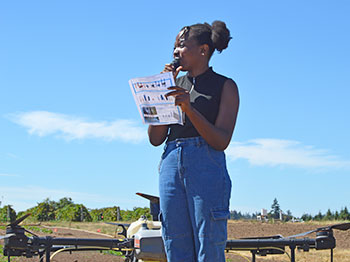Researchers Studying Attract-and-Kill Formula for SWD
With the addition of attractants, growers may be able to achieve control of spotted wing drosophila with a minimal amount of insecticide, even just a few droplets, according to a presentation at the OSU Blueberry Field Day July 24 at the North Willamette Research and Extension Center in Aurora.
 |
Chisom Molokwu at the OSU Blueberry Field Day presents on a study into using a technique known as “attract and kill” for controlling spotted wing drosophila in blueberries. |
“This is something I believe is fundamentally going to change how we’re going to deal with this drosophila Suzukii,” said Oregon State University Extension entomologist Vaughn Walton. “What our data is showing is that we don’t need high volume anymore. We can attract the insects to droplets, which will be applied by a drone.”
The technique, known as “attract and kill,” involves combining attractants with insecticides. Researchers are finding good results while investigating which combination of attractants and insecticides are most effective.
“The data is looking really good,” Walton said. “We are showing similar efficacy level to full-cover applications.”
In a presentation at the field day, Chisom Molokwu, who is working with Walton on the concept, said researchers have seen good fly mortality and lower egg laying in studying attract and kill.
Research data shows that egg laying was lower with Combi-Protec and Decoy combined with Entrust as a toxicant when compared to the untreated control, and SWD mortality rates were higher with both Combi-Protec and Decoy combined with Entrust as a toxicant.
Other combinations of attractants with insecticides, including with Pyganic, were not as successful, Walton said. “This combination did not provide crop protection against SWD,” he said.
Walton noted that research into improving control options against the spotted wing drosophila has been a group effort, dating back to 2009, when SWD was first found in Oregon.
“I’ve worked with Jana Lee on the drosophila Suzukii since 2009 and the work has been funded by the USDA, the blueberry industry. We have collaborators now from Pratum (Co-op). We have other collaborators from private industry. So this has been a team effort,” he said.
Further research, including grower trials with the Combi-Protec and Entrust combination, are planned for the future, Walton said.